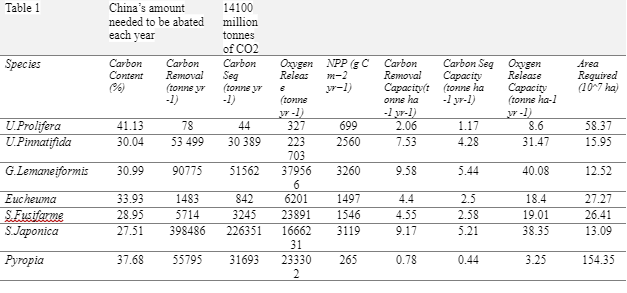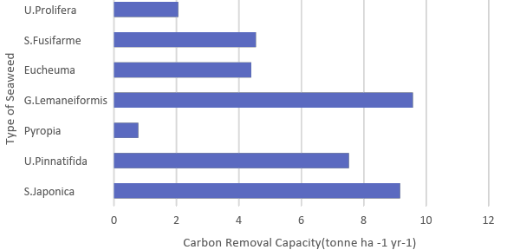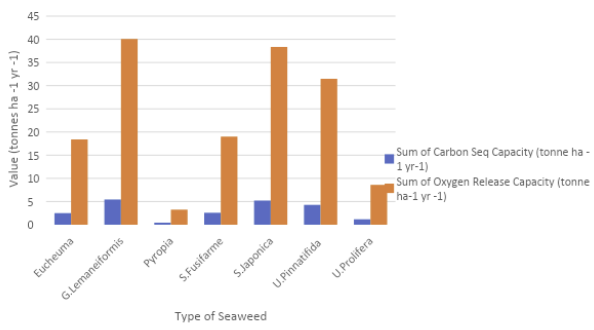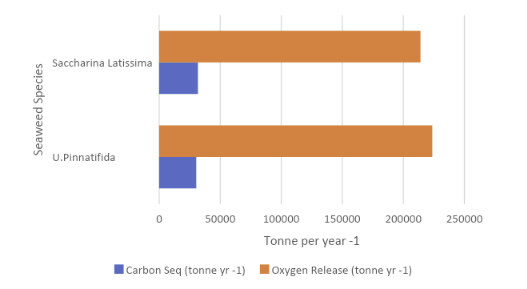· 12 min read
In order to attain net-zero CO2 emissions by 2050, nations must comply with the climate goals outlined in the Paris Agreement. The concept of a finite carbon budget compatible with stabilizing warming at a given level (1.5°C or 2.0°C) is supported by the clear evidence that our cumulative carbon emissions, regardless of the specific mission pathway up until net zero global emissions, are the single most significant determinant on peak warming.
Nations and organizations that have set up net zero targets may find it challenging to achieve their goals due to expenditure barriers, lack of regulation, and a lack of experiential and technical know-how. Achieving net-zero emissions targets may be aided by nature-based climate solutions that work to protect and improve carbon storage in terrestrial or aquatic ecosystems (Matthews et al., 2021).
Nature-based solutions
The term “Nature-based Climate Solutions” (NbCS) refers to a group of carbon direct removal techniques that attempt to protect and improve carbon storage in ecosystems and agricultural areas. NbCS’s ability to aid in climate change mitigation efforts while producing extra co-benefits for biodiversity and human well-being is a significant attraction.
Seaweed as a nature-based carbon capture, utilisation and storage technique
One of the most scalable natural solutions for removing carbon emissions is seaweed as it has the potential to simultaneously decarbonize the economy and sequester carbon from the ocean’s surface. Seaweed also has superior carbon fixation efficiency than terrestrial plants, meaning that they can convert solar energy into primary photosynthetic biomass, giving them incomparable advantages in atmospheric carbon absorption (Gao & McKinley, 1994).
Through photosynthetic primary production, seaweed fixes carbon as it expands in the ocean’s sunlight zone, are good biomass producers as they can also grow very quickly. In optimal conditions, some species of seaweed, such as Macrocystis pyrifera, can grow up to 50 centimetres daily and reach lengths of up to 60 meters (Edwards, 2017).
The lack of quantifiable evidence to support the science and literature that already exist that illustrates how seaweed is calculable to meet net zero abatement goals is the current research gap regarding the potential of seaweed to achieve net zero ambitions for companies and countries. Therefore, an analysis is performed to understand how much CO2 can be abated using seaweed based on sequestration calculations from the literature and the amount required to abate each year for countries such as China, Australia, the USA and the UK.
Methodology
Statistical calculations were drawn to determine a seaweed’s sequestration potential, oxygen release, net production productivity (NPP) and the area needed to cultivate seaweed and reach carbon neutrality to determine which seaweed would be the best in each respective region.
The types of seaweed chosen for each region below were based on the most common type local to the area. The study aims to eliminate the threat of invasive seaweed systems that may disrupt biodiversity.
Carbon sequestration
Carbon sequestration is the quantity of carbon that can be stored in the ocean for a long term (more than 100 years) (Gao et. al., 2021). Carbon sequestration with seaweed takes place when a large proportion of the plant material is not harvested but left to disintegrate into the ocean, breaking down into particle organic carbon that falls to the ocean bed and stored in sediment or stays as refractory organic carbon (ROC). The carbon content of each type of seaweed was derived from several sources (FAO, 2019; Gao et al., 2021; Hairiah et al., 2001). According to Gao et al. (2021), the amount of sequestration and NPP can be determined using the following formula:
- Carbon sequestration (Cs) - POCb1 + POCb2 + POCe + rDOC
- Net primary productivity (NPP)= POCh + POCl + DOCe
POC stands for particle organic content and DOC stands for dissolved organic carbon.
The formulas above are based on merging Krause-Jensen and Duarte (2016) and Zhang et al.(2017).
In the calculations
- POCb1 = POC buried in the algal bed,
- POCb2 = POC buried in the shelf
- POCe = POC exported to the deep sea,
- rDOC = refractory DOC (dissolved organic carbon),
- POCh = harvested POC, POCl - lost POC due to remineralization, breakoff, etc., equal to the sum of the remineralized and grazed POC, POCb1, POCb2 and POCe ,
- DOCe = excreted DOC by seaweeds.

The area required for carbon neutrality and sensitivity analysis
The area required to achieve net zero for each type of species is derived from the formula:
ACi = TC /Csi.
TCis the total amount of CO2 required to be annually sequestered to accomplish a country’s carbon neutrality goal. Csi is the capacity for carbon sequestration (Gao et al., 2021).
A sensitivity analysis was then performed to understand which component in the seaweed cultivation process contributed the most to achieving carbon neutrality in a specific region. To determine its impact on the area, the baseline value of each input was changed by 30 percent for this analysis while all other input factors remained constant (Gao et. al., 2021).
Release of oxygen
The equation for photosynthesis was used to determine the amount of oxygen released by cultivating seaweed.
6CO2+ 6H2O 🡪 C6H12O6 + 6O2
Therefore, 2.67 tonnes of O2 is generated for every tonne of carbon is fixed (Gao et al., 2021). The carbon involved in this equation includes both the harvested carbon and the sequestrated carbon.
Results
The quantity of carbon removed per area by each region’s local type of seaweed was calculated using the equations above, showing varying results across sequestration, removal capacity, net production productivity and oxygen release capacity.







Discussion
Quantifying the impact of using nature-based CCS solutions such as seaweed is crucial to investigate its potential as a blue carbon sink and support further policymaking to catalyse action towards net zero. The seaweed types highlighted as the best carbon dioxide abatement species were G.Lemmanions and S.Japonica for China, U.Pinnatifida for the US and UK and U.Pinnatifida and Ecklonia radiata for Australia. These species were considered the most suitable due to their high carbon sequestration capacities as well as requiring the least amount of area for abatement procedures.
A high carbon dioxide sequestration capacity requiring less area is considered suitable due to the potential cost that the project may incur. This study does not account for the cost of running the projects; however, the efficiency of these species in abating emissions for their respective targets can translate to lower costs, especially for legal permit requirements for land cultivation.
It is important to note that the area required for each species in each country varies significantly and may be influenced by various factors, such as climate and available land for seaweed cultivation. In terms of the feasibility of using seaweed as a carbon capture and storage solution, it is essential to consider the costs and benefits of each species. For example, while S.Japonica may have a higher carbon sequestration capacity in China, it also requires a much larger area, which may not be feasible in terms of land availability or cost.
Incorporating other formulas to look at how a seaweed ecosystem would work, with factors such as oxygen generation and carbon dioxide sequestration capacity per hectare, it highlights the trade-offs that could occur between factors such as a type of seaweed having a larger carbon sequestration capacity but less oxygen being produced or less NPP. Previous studies have failed to highlight these connections when discussing the abatement potential of seaweed species. This research proves that various seaweed species have varying potentials for carbon sequestration and removal. The most suitable species will depend on multiple factors, such as climate, land availability, and cost. However, it is crucial to consider the feasibility of implementing large-scale seaweed cultivation in each country. Factors such as the availability of suitable coastlines, the infrastructure for seaweed cultivation, and the potential impact on the marine ecosystem must be considered (Gao et. al., 2021).
Seaweed product application – developed and emerging markets
Seaweed provides a range of product applications that could scale the European seaweed industry to a USD 9.3b value by 2030, of which 30 percent of the seaweed supplied is grown in Europe. This can create significant environmental benefits, mitigating >5m t¹of CO2e emissions per annum, absorbing 20,000 tonnes of nitrogen and 2,000 tonnes of phosphorous from the ocean per annum, providing ecosystem services, and having a strong social impact. Ultimately, this could lead to the creation of 11,500 jobs for a wide range of skills and expertise. However, the nascent European seaweed industry must accelerate and significantly grow its production capacity from 300 tonnes of fresh-weight seaweed produced today to more than 8 million tonnes of fresh-weight seaweed by 2030 to live up to this potential (Seaweed for Europe, 2020).
Overall challenges
There may be a number of issues that limit the growth of seaweed as a nature-based climate solution. Complex processes are used to utilise carbon in farms and natural seaweed beds. More data will be needed to appropriately estimate net GHG drawdown by these systems under various scenarios, notwithstanding the extensive data gathering and modelling efforts currently under progress (such as farm operation or the disposition of seaweed products). This will also require a better understanding of and modelling of system dynamics. Large masses of seaweed being sunk to the ocean floor as a method will have negative ecological and biogeochemical repercussions (United Nations Global Compact, 2022). There is currently little knowledge of the populations and interactions of the different oceanic creatures.
Furthermore, these results assume that the seaweed is grown and harvested in an optimal manner, with proper management and maintenance practices guidelines. Moreover, these results do not consider potential variations in seaweed growth and carbon sequestration due to factors such as temperature, salinity, and nutrient availability. Another consideration is the feasibility of scaling up seaweed cultivation to meet the demands of carbon sequestration on a larger scale. While seaweed has shown promise as a carbon sequestration solution, further research and development are needed to understand the potential for widespread implementation. This could include exploring innovative cultivation techniques and identifying the most suitable species for different regions.
Using a biological tool to offset emissions
There are several issues with the extensive use of biological, or “nature-based,” carbon removal to offset ongoing fossil fuel usage. The biosphere’s function as a net sink is threatened by feedback from climate change itself, such as rising microbial respiration in warming soils and rising wildfire danger, among other effects. Significant potential for direct and indirect carbon leakage, climate effects of non-carbon sources and the consequences for global and generational equity. These factors also create a significant reputational and financial risk for any corporation depending on biological carbon storage to offset the continued use of fossil fuels, despite being relatively inexpensive (Esposito et al., 2010).
Public willingness – Nimbyism
The concept of Nimbyism is a major deciding factor for new innovation and projects. Nimbyism is a term to describe ‘not in my backyard’. For example, people who support an idea such as wind turbines, but they do not want it to be in their vicinity i.e. their backyard (ESCP, 2022). Poor public support has resulted in project delays and, in some cases, project cancellation. On the other hand, a project’s acceptance and community support seem to be crucial to its advancement.
Life cycle assessment
Using seaweed as a CCS solution is a significant step towards depending on nature-based solutions to decarbonise hard-to-abate emissions and everyday emissions. However, the entire life cycle of carbon needs to be examined to understand the climate effects of seaweed (Hasselström & Thomas, 2022). Life cycle carbon accounting is a practical method that offers a systems perspective on the climatic performance of product systems. It has been used with different types of biomasses, such as in the forestry industry (Alice-Guier et al., 2020; Cowie et al., 2021). This means that when evaluating climatic impacts, the entire life cycle, from birth to grave, should be considered.
The halocarbon emissions from seaweed are another well-known knowledge gap. In reaction to biotic and abiotic stress, halogenated chemicals are generated from seaweed. These gases can potentially impact the lifetime of other greenhouse gases, cloud formation, and global biogeochemical cycles. However, the existing literature still doesn’t fully clarify the scope of this emission or any potential species-specific or cultivar-specific variations
Business models
To ensure the sustainability of seaweed-based CCS, business models are essential since they outline how risk and reward will be distributed. Viable business models can provide developers a competitive edge while encouraging other companies to enter the market, according to authorities (Kapetaki & Scowcroft, 2017). By examining the projects’ incentives, it is evident that European CCS activities are primarily motivated by climate goals. Still, North American CCS programs are more rational and focused on specific goals, such as, for example, generating income from CO2 sales (Kapetaki & Scowcroft, 2017). These projects must overcome some particular difficulties because they assess the likelihood of obtaining financing for a growing industry in markets where support and policy mechanisms are still changing and for projects whose structures and risk-sharing arrangements are frequently still being established (Kapetaki & Scowcroft, 2017).
Conclusion
By 2100, it is necessary to remove 2–20 Gt of CO2 from the atmosphere annually to moderate climate change. To have a significant impact, seaweed-based CCS will need widespread adoption, necessitating the creation by power utilities of thorough business models that incorporate concerns related to electricity production, CO2 capture, CO2 transport, utilization revenue, and CO2 storage (UNEP,2022).
Despite the promising results in carbon sequestration, further research needs to be taken to understand the economic feasibility for each region, the scalability of each solution and the life cycle assessment of seaweed from production to sinking on the seabed. The calculations supported the research questions and allowed to close the gap in knowledge in the potential of seaweed’s capacity to abate emissions and regenerate oxygen.
Nevertheless, understanding the foundation behind using seaweed as a CCS solution is a stepping stone towards creating a future defined by nature-based solutions as we approach our net zero goals. To regenerate the earth’s balance damaged due to human-induced activity, incorporating nature-based climate control solutions is vital for developing carbon-neutral technologies and ambitions.
illuminem Voices is a democratic space presenting the thoughts and opinions of leading Energy & Sustainability writers, their opinions do not necessarily represent those of illuminem.






